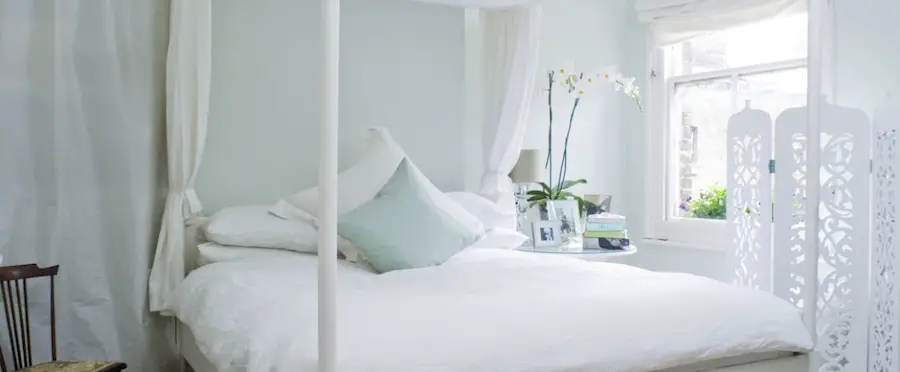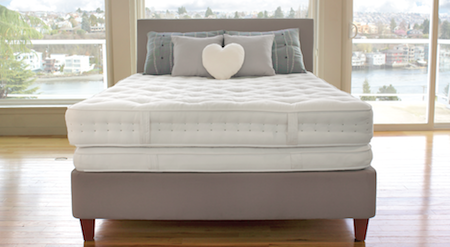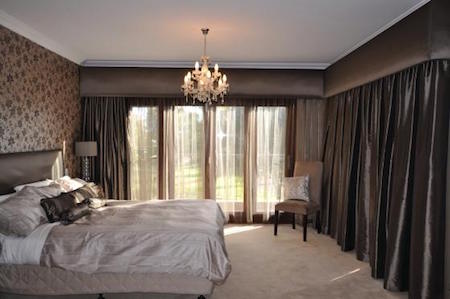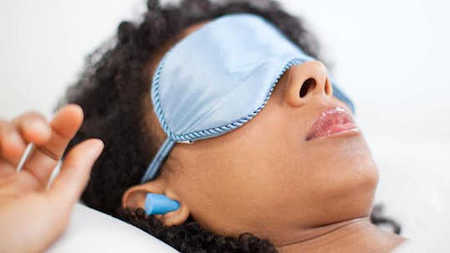How your bedroom is arranged plays a key part in quality of sleep, duration and ease of falling asleep. Today, we’re analyzing the key components of a relaxing environment including the best temperature, blackout curtains and the best essential oils.

How to create the perfect sleep setup
So, how do we make sure we’re doing everything right? It’s a gradual shift, and overall, it’s about changing our habits. First, it’s good to get into the habit of a solid bedtime routine.
Next, let’s discuss how to make sure your bedroom is set up for a good night’s rest.
Let the bedroom serve its purpose (and nothing but)

The bedroom should ideally be reserved for sleep and sex, and nothing else. During the day, it can be used for dressing and naps, but in general, the fewer associations we have with our bedrooms, the better.
If you’re accustomed to reading or writing in the bedroom, working or studying in the bedroom, or eating and watching television in the bedroom, start dismantling these habits ASAP!
If you work from home and you find yourself working from bed, do yourself a favor and get a desk. If you have a television in the room, relocate it. These pesky habits are comforting and easy to get into, but they impact sleep negatively, especially if you’re partaking right before bed.
It’s easy to lose track of time when we’re “winding down” before bed, or “just finishing up a few emails.” When you hit the sack, you should be ready to enter dream mode for the night.
Your brain should know when you walk through that door what’s going to happen – sleep! Otherwise, you’re instilling some natural tendency for the brain to become stimulated upon getting in bed.
There’s magic in the mattress

It probably goes without saying that the biggest thing to address – especially if your sleep is lacking – is the actual surface on which you sleep! A mattress can cost quite a bit of money, but it’s a solid investment.
Think about your preferences, and choose wisely: Do you prefer a soft or firm mattress? Do you need a larger mattress? Is the splurge for memory foam worth it?
If you can’t foot the bill for a brand new mattress, consider a mattress topper for your current digs.
While purchasing a new mattress, it might be helpful to choose a non-toxic mattress which can help you to avoid any surprise chemicals, thus avoiding negative reactions from skin sensitivities to toxins in the household.
The skin is the body’s largest organ, so it takes in a lot of its surroundings. Organic material is also desirable when shopping for a mattress.
We recommend latex and organic cotton; these two are low-tox materials to seek out when you shop for a new, quality bed. My Green Mattress incorporates both, and this mattress comes in all sizes.
Consider purchasing organic pillows filled with buckwheat or something besides synthetic material. Check out more of our product recommendations for getting a good night’s sleep.
Controlling the light

A dark room is a room ready for sleep. Circadian rhythm has much to do with light, and while we highly recommend natural light throughout the day to promote restful sleep later, we recommend as complete darkness as possible at night.
Here are a few ways to ensure that your room has proper lighting (or lack thereof):
- Blackout curtains. When the curtains are closed, there should be no room for any light to peek through. Go for blackout curtains to keep any light – natural or artificial – from bleeding into your space at night. They’re especially useful if you live on a brightly lit street, or if your windows face a road with a lot of traffic.
- Check for glowing objects. Alarm clocks, wall chargers, your phone, the television or the cable box, the wifi router, a smoke detector – those tiny lights make a big impact. Unplug or relocate your tech-y objects altogether. As for alarm clocks, kick it old school with a non-digital clock, box up your digital digs in a drawer where the light can’t escape, or purchase an alarm clock with a “smart light” like this model.
- Close the door. As with the windows, it’s good to eliminate the potential for any unwanted lights (and sounds!) to find their way into your sleep space. While you might leave the door open for a convenient reason, such as a pet, it’s good to get in the habit of closing it shut.
- Use an eye mask. If there are issues regarding lighting that are outside of your control, an eye mask is a simple fix and affordable solution. Even if you’re “blacked out” as far as the eye can see, an eye mask can still be useful.
Sleep in a cool room

Temperature control is another huge factor in a good night’s rest. The best temperature for sleep is between 60°F (15°C) and 75°F (24°C). Like with a mattress, temperature preference is highly individual, but you will sleep better at a cooler temperature.
Circadian rhythm is reinforced by the rise and fall of body temperature, the latter of which should come at bedtime. In the morning, you’ll “wake up” as your body temperature rises.
Considering the body is going to naturally cool down a few hours prior to hitting the hay, and throughout the night, controlling the temperature beforehand can help you to fall asleep more quickly and achieve deeper sleep.
A lower body temperature is actually part of why you feel tired at night! Cooler sleeping climates can also increase the amount of calories you burn on a daily basis and increase brown fat in the body, which can aid in weight loss.
Silence is golden

If you’re not ensuring a silent night, this could be why your sleep is suffering. Some people claim to fall asleep better with the television or music on in the background, but we’re willing to bet this is just a bad habit being justified.
While it may feel comfortable, it could be compromising sleep quality.
For the overall environment, the less technology in the bedroom, the better. If you have a television in the bedroom, it’s time to relocate. Turn the wifi off and airplane mode on when you’re getting ready for bed which will cease all notifications, thus preventing any surprise dings or rings.
Another useful tool to keep bedside is a comfortable pair of ear plugs. This will dull any of those faint and distant noises, or drown out background noise if you live with roommates or a partner on a different sleeping schedule than you are.
If silence doesn’t quite do it for you, we also recommend white noise machines which can help drown out invasive sounds as it literally blocks out certain frequencies.
Sharing too much space?
We’re not suggesting that you kick your partner out of the room, although if your sleep patterns and quirks are too incompatible, it could be worth looking into other solutions.
Here are some basic tips for effectively sharing space for the long-term while improving everyone’s quality of sleep:
- Upgrade from a full-size mattress to a queen or king size mattress if you’re sharing the bed.
- Invest in a memory foam mattress so your partner’s movement disturbs your sleep less.
- Get a bigger blanket, or simply opt to sleep with separate blankets so nobody steals the covers in the night.
- Invest in moisture-wicking sheets to prevent body heat from creating too warm an environment.
Now, you can get to work on creating the ultimate sleep cave. Think of it as a fun project. We can all afford to declutter a little bit. By addressing our physical surroundings and optimising their impact on our slumber, we can then move on to just-as-important internal factors.
If you need help doing so, consider signing up for our free 7-Day Sleep Better Challenge where we help you build the habits to restore your rest and feel your best.
Music, mountains, dogs, travel, food and friends.
